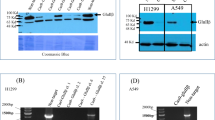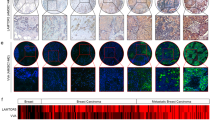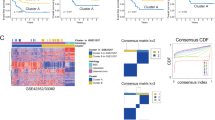Abstract
Golgi β1,6N-acetylglucosaminyltransferase V (MGAT5) is required in the biosynthesis of β1,6GlcNAc-branched N-linked glycans attached to cell surface and secreted glycoproteins. Amounts of MGAT5 glycan products are commonly increased in malignancies, and correlate with disease progression. To study the functions of these N-glycans in development and disease, we generated mice deficient in Mgat5 by targeted gene mutation. These Mgat5−/− mice lacked Mgat5 products and appeared normal, but differed in their responses to certain extrinsic conditions. Mammary tumor growth and metastases induced by the polyomavirus middle T oncogene was considerably less in Mgat5−/− mice than in transgenic littermates expressing Mgat5. Furthermore, Mgat5 glycan products stimulated membrane ruffling and phosphatidylinositol 3 kinase–protein kinase B activation, fueling a positive feedback loop that amplified oncogene signaling and tumor growth in vivo. Our results indicate that inhibitors of MGAT5 might be useful in the treatment of malignancies by targeting their dependency on focal adhesion signaling for growth and metastasis.
This is a preview of subscription content, access via your institution
Access options
Subscribe to this journal
Receive 12 print issues and online access
$209.00 per year
only $17.42 per issue
Buy this article
- Purchase on Springer Link
- Instant access to full article PDF
Prices may be subject to local taxes which are calculated during checkout






Similar content being viewed by others
References
Yamashita, K., Ohkura, T., Tachibana, Y., Takasaki, S. & Kobata, A. Comparative study of the oligosaccharides released from baby hamster kidney cells and their polyoma transformant by hydrazinolysis. J. Biol. Chem. 259, 10834–10840 (1984).
Pierce, M. & Arango, J. Rous sarcoma virus-transformed baby hamster kidney cells express higher levels of asparagine-linked tri- and tetraantennary glycopeptides containing [GlcNAc-β(1,6)Man-α(1,6)Man] and poly-N-acetyllactosamine sequences than baby hamster kidney cells. J. Biol. Chem. 261, 10772–10777 (1986).
Cummings, R.D., Trowbridge, I.S. & Kornfeld, S. A mouse lymphoma cell line resistant to the leukoagglutinating lectin from Phaseolus vulgaris is deficient in UDP-GlcNAc:α-D-mannoside β1,6 N-acetylglucosaminyltransferase. J. Biol. Chem. 257, 13421–13427 (1982).
Shoreibah, M., et al. Isolation, characterization, and expression of cDNA encoding N-Acetylglucosaminyltransferase V. J. Biol. Chem. 268, 15381–15385 (1993).
Cummings, R.D. & Kornfeld, S. Characterization of the structural determinants required for the high affinity interaction of asparagine-linked oligosaccharides with immobilized Phaseolus vulgaris leukoagglutinating and erythroagglutinating lectin. J. Biol. Chem. 257, 11230–11234 (1982).
Fernandes, B., Sagman, U., Auger, M., Demetriou, M. & Dennis, J.W. β1-6 branched oligosaccharides as a marker of tumor progression in human breast and colon neoplasia. Cancer Res. 51, 718–723 (1991).
Seelentag, W.K. et al. Prognostic value of β1,6-branched oligosaccharides in human colorectal carcinoma. Cancer Res. 58, 5559–5564 (1998).
Yamashita, K., Tachibana, Y., Ohkura, T. & Kobata, A. Enzymatic basis for the structural changes of asparagine-linked sugar chains of membrane glycoproteins of baby hamster kidney cells induced by polyoma transformation. J. Biol. Chem. 260, 3963–3969 (1985).
Dennis, J.W., Kosh, K., Bryce, D.-M. & Breitman, M.L. Oncogenes conferring metastatic potential induce increased branching of Asn-linked oligosaccharides in rat2 fibroblasts. Oncogene 4, 853–860 (1989).
Dennis, J.W., Laferte, S., Waghorne, C., Breitman, M.L. & Kerbel, R.S. β1-6 branching of Asn-linked oligosaccharides is directly associated with metastasis. Science 236, 582–585 (1987).
Kang, R. et al. Transcriptional regulation of the N-acetylglucosaminyltranserase V gene in human bile duct carcinoma cells (HuCC-T1) is mediated by Ets-1. J. Biol. Chem. 271, 26706–26712 (1996).
Chen, L., Zhang, W., Fregien, N. & Pierce, M. The her-2/neu oncogene stimulates the transcription of N-acetylglucosaminyltransferase V and expression of its cell surface oligosaccharide products. Oncogene 17, 2087–2093 (1998).
Lu, Y., Pelling, J.C. & Chaney, W.G. Tumor cells surface β1-6 branched oligosaccharides and lung metastasis. Clin. Exp. Metastasis 12, 47–54 (1994).
Demetriou, M., Nabi, I.R., Coppolino, M., Dedhar, S. & Dennis, J.W. Reduced contact inhibition and substratum adhesion in epithelial cells expressing GlcNAc-transferase V. J. Cell Biol. 130, 383–392 (1995).
Seberger, P.J. & Chaney, W.G. Control of metastasis by asn-linked, β1-6 branched oligosaccharides in mouse mammary cancer cells. Glycobiology 9, 235–241 (1999).
Do, K.-Y., Fregien, N., Pierce, M. & Cummings, R.D. Modification of glycoproteins by N-acetylglucosaminyltransferase V is greatly influenced by accessibility of the enzyme to oligosacharide acceptors. J. Biol. Chem. 269, 23456–23464 (1994).
Nakagawa, H. et al. Detailed oligosaccharide structures of human integrin alpha 5 beta 1 analyzed by a three-dimensional mapping technique. Eur. J. Biochem. 237, 76–85 (1996).
Asada, M., Furukawa, K., Kantor, C., Gahmberg, C.G. & Kobata, A. Structural study of the sugar chains of human leukocyte cell adhesion molecules CD11/CD18. Biochemistry 30, 1561–1571 (1991).
Skelton, T.P., Zeng, C., Nocks, A. & Stamenkovic, I. Glycosylation provides both stimulatory and inhibitory effects on cell surface and soluble CD44 binding to hyaluronan. J. Cell Biol. 140, 431–446 (1998).
Diamond, M.S., Staunton, D.E., Martin, S.D. & Springer, T.A. Binding of the integrin Mac-1 (CD11b/CD18) to the third immunoglobulin-like domain of ICAM-1 (CD54) and its regulation by glycosylation. Cell 65, 961–971 (1991).
McEvoy, L.M., Sun, H., Frelinger, J.G. & Butcher, E.C. Anti-CD43 inhibition of T cell homing. J. Exp. Med. 185, 1493–1498 (1997).
Verbeek, B.S. et al. c-Src protein expression is increased in human breast cancer. An immunohistochemical and biochemical analysis. J. Pathol. 180, 383–388 (1996)
Liu, A.X. et al. AKT2, a member of the protein kinase B family, is activated by growth factors, v-Ha-ras, and v-src through phosphatidylinositol 3-kinase in human ovarian epithelial cancer cells. Cancer Res. 58, 2973–2977 (1998).
Dilworth, S.M. et al. Transformation by polyoma virus middle T-antigen involves the binding and tyrosine phosphorylation of Shc. Nature 367, 87–90 (1994).
Whitman, M., Kaplan, D.R., Schaffhausen, B., Cantley, L. & Roberts, T.M. Association of phosphatidylinositol kinase activity with polyoma middle-T competent for transformation. Nature 315, 239–242 (1985).
Guy, C.T., Muthuswamy, S.K., Cardiff, R.D., Soriano, P. & Muller, W.J. Activation of the c-Src tyrosine kinase is required for the induction of mammary tumors in transgenic mice. Genes Dev. 1, 23–32 (1994).
Webster, M.A. et al. Requirement for both Shc and phosphatidylinositol 3′ kinase signaling pathways in polyomavirus middle T-mediated mammary tumorigenesis. Mol. Cell. Biol. 18, 2344–2359 (1998).
Guy, C.T., Cardiff, R.D. & Muller, W.J. Induction of mammary tumors by expression of polyomavirus middle T oncogene: a transgenic mouse model for metastatic disease. Mol. Cell. Biol. 12, 954–961 (1992).
Bronson, R., Dawe, C., Carroll, J. & Benjamin, T. Tumor induction by a transformation-defective polyoma virus mutant blocked in signaling through Shc. Proc. Natl. Acad. Sci. USA 94, 7954–7958 (1997).
Granovsky, M. et al. GlcNAc-transferase V and core 2 GlcNAc-transferase expression in the developing mouse embryo. Glycobiology 5, 797–806 (1995).
Turner, C.E. Molecules in focus, paxillin. Int. J. Biol. Macromol. 30, 955–959 (1998).
Reif, K., Nobes, C.D., Thomas, G., Hall, A. & Cantrell, D.A. phosphatidylinositol 3-kinase signals activate a selective subset of Rac/Rho dependent effector pathways. Curr. Biol. 6, 1445–1455 (1996).
Spector, I., Shochet, N.R., Blasberger, D. & Kashman, Y. Latrunculins, novel marine macrolides that disrupt microfilament organization and affect cell growth: I. Comparison with cytochalasin D. Cell Motil. Cytoskeleton 13, 127–124 (1989).
Cheng, A.M. et al. Mammalian Grb2 regulates multiple steps in embryonic development and malignant transformation. Cell 95, 793–803 (1999).
Neznanov, N. et al. A single targeted Ets2 allele restricts development of mammary tumors in transgenic mice. Cancer Res. 59, 4242–4246 (1999).
Keely, P.J., Westwick, J.K., Whitehead, I.P., Der, C.J. & Parise, L.V. Cdc42 and Rac1 induce integrin-mediated cell motility and invasiveness through PI(3)K. Nature 390, 632–636 (1997).
King, W.G., Mattaliano, M.D., Chan, T.O., Tsichlis, P.N. & Brugge, J.S. Phosphatidylinositol 3-kinase is required for integrin-stimulated AKT and Raf-1/mitogen-activated protein kinase pathway activation. Mol. Biol. Cell 17, 4406–4418 (1997).
Humphries, M.J., Matsumoto, K., White, S.L. & Olden, K. Oligosaccharide modification by swainsonine treatment inhibits pulmonary colonization by B16–F10 murine melanoma cells. Proc. Natl. Acad. Sci. USA 83, 1752–1756 (1986).
Dennis, J.W. Effects of swainsonine and polyinosinic-polycytidylic acid on murine tumor cell growth and metastasis. Cancer Res. 46, 5131–5136 (1986).
Goss, P.E., Baptiste, J., Fernandes, B., Baker, M. & Dennis, J.W. A study of swainsonine in patients with advanced malignancies. Cancer Res. 54, 1450–1457 (1994).
Hasty, P. & Bradley, A. in Gene Targeting. A Practical Approach (ed. Joyner, A.) 138–180 (IRL Oxford Press, 1993).
Acknowledgements
The authors thank C. Warren, S. Kulkarni and P. Cheung for suggestions. This research was supported by grants from National Cancer Institute of Canada, the Mizutani Foundation, the National Science and Engineering Research Council of Canada, and GlycoDesign (Toronto, Canada). W.J.M. is supported by a Medical Research Council Scientist Award.
Author information
Authors and Affiliations
Corresponding author
Rights and permissions
About this article
Cite this article
Granovsky, M., Fata, J., Pawling, J. et al. Suppression of tumor growth and metastasis in Mgat5-deficient mice. Nat Med 6, 306–312 (2000). https://doi.org/10.1038/73163
Received:
Accepted:
Issue Date:
DOI: https://doi.org/10.1038/73163
This article is cited by
-
Aberrant N-glycosylation in cancer: MGAT5 and β1,6-GlcNAc branched N-glycans as critical regulators of tumor development and progression
Cellular Oncology (2023)
-
Structural insights into Siglec-15 reveal glycosylation dependency for its interaction with T cells through integrin CD11b
Nature Communications (2023)
-
The jam session between muscle stem cells and the extracellular matrix in the tissue microenvironment
npj Regenerative Medicine (2022)
-
Shedding of N-acetylglucosaminyltransferase-V is regulated by maturity of cellular N-glycan
Communications Biology (2022)
-
Discovery of a lectin domain that regulates enzyme activity in mouse N-acetylglucosaminyltransferase-IVa (MGAT4A)
Communications Biology (2022)



